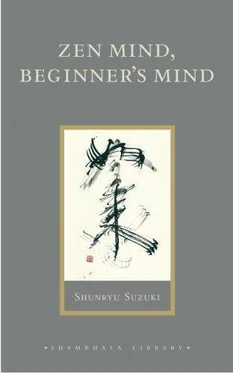RICHARD BAKER Kyoto, 1970
“In the beginner’s mind there are many possibilities, hut in the expert’s there are few.”
People say that practicing Zen is difficult, but there is a misunderstanding as to why. It is not difficult because it is hard to sit in the cross-legged position, or to attain enlightenment. It is difficult because it is hard to keep our mind pure and our practice pure in its fundamental sense. The Zen school developed in many ways after it was established in China, but at the same time, it became more and more impure. But I do not want to talk about Chinese Zen or the history of Zen. I am interested in helping you keep your practice from becoming impure.
In Japan we have the phrase shoshin, which means “beginner’s mind.” The goal of practice is always to keep our beginner’s mind. Suppose you recite the Prajna Paramita Sutra only once. It might be a very good recitation. But what would happen to you if you recited it twice, three times, four times, or more? You might easily lose your original attitude towards it. The same thing will happen in your other Zen practices. For a while you will keep your beginner’s mind, but if you continue to practice one, two, three years or more, although you may improve some, you are liable to lose the limitless meaning of original mind.
For Zen students the most important thing is not to be dualistic. Our “original mind” includes everything within itself. It is always rich and sufficient within itself. You should not lose your self-sufficient state of mind. This does not mean a closed mind, but actually an empty mind and a ready mind. If your mind is empty, it is always ready for anything; it is open to everything. In the beginner’s mind there are many possibilities; in the expert’s mind there are few.
If you discriminate too much, you limit yourself. If you are too demanding or too greedy, your mind is not rich and self-sufficient. If we lose our original self-sufficient mind, we will lose all precepts. When your mind becomes demanding, when you long for something, you will end up violating your own precepts: not to tell lies, not to steal, not to kill, not to be immoral, and so forth. If you keep your original mind, the precepts will keep themselves.
In the beginner’s mind there is no thought, “I have attained something.” All self-centered thoughts limit our vast mind. When we have no thought of achievement, no thought of self, we are true beginners. Then we can really learn something. The beginner’s mind is the mind of compassion. When our mind is compassionate, it is boundless. Dogen-zenji, the founder of our school, always emphasized how important it is to resume our boundless original mind. Then we are always true to ourselves, in sympathy with all beings, and can actually practice.
So the most difficult thing is always to keep your beginner’s mind. There is no need to have a deep understanding of Zen. Even though you read much Zen literature, you must read each sentence with a fresh mind. You should not say, “I know what Zen is,” or “I have attained enlightenment.” This is also the real secret of the arts: always be a beginner. Be very very careful about this point. If you start to practice zazen, you will begin to appreciate your beginner’s mind. It is the secret of Zen practice.
“Zazen practice is the direct expression of our true nature.
Strictly speaking, for a human being, there is no other practice than this practice; there is no other way of life than this way of life.”
Now I would like to talk about our zazen posture. When you sit in the full lotus position, your left foot is on your right thigh, and your right foot is on your left thigh. When we cross our legs like this, even though we have a right leg and a left leg, they have become one. The position expresses the oneness of duality: not two, and not one. This is the most important teaching: not two, and not one. Our body and mind are not two and not one. If you think your body and mind are two, that is wrong; if you think that they are one, that is also wrong. Our body and mind are both two and one. We usually think that if something is not one, it is more than one; if it is not singular, it is plural. But in actual experience, our life is not only plural, but also singular. Each one of us is both dependent and independent.
After some years we will die. If we just think that it is the end of our life, this will be the wrong understanding. But, on the other hand, if we think that we do not die, this is also wrong. We die, and we do not die. This is the right understanding. Some people may say that our mind or soul exists forever, and it is only our physical body which dies. But this is not exactly right, because both mind and body have their end. But at the same time it is also true that they exist eternally. And even though we say mind and body, they are actually two sides of one coin. This is the right understanding. So when we take this posture it symbolizes this truth. When I have the left foot on the right side of my body, and the right foot on the left side of my body, I do not know which is which. So either may be the left or the right side.
The most important thing in taking the zazen posture is to keep your spine straight. Your ears and your shoulders should be on one line. Relax your shoulders, and push up towards the ceiling with the back of your head. And you should pull your chin in. When your chin is tilted up, you have no strength in your posture; you are probably dreaming. Also to gain strength in your posture, press your diaphragm down towards your hara, or lower abdomen. This will help you maintain your physical and mental balance. When you try to keep this posture, at first you may find some difficulty breathing naturally, but when you get accustomed to it you will be able to breathe naturally and deeply.
Your hands should form the “cosmic mudra.” If you put your left hand on top of your right, middle joints of your middle fingers together, and touch your thumbs lightly together (as if you held a piece of paper between them), your hands will make a beautiful oval. You should keep this universal mudra with great care, as if you were holding something very precious in your hand. Your hands should be held against your body, with your thumbs at about the height of your navel. Hold your arms freely and easily, and slightly away from your body, as if you held an egg under each arm without breaking it.
You should not be tilted sideways, backwards, or forwards. You should be sitting straight up as if you were supporting the sky with your head. This is not just form or breathing. It expresses the key point of Buddhism. It is a perfect expression of your Buddha nature. If you want true understanding of Buddhism, you should practice this way. These forms are not a means of obtaining the right state of mind. To take this posture itself is the purpose of our practice. When you have this posture, you have the right state of mind, so there is no need to try to attain some special state. When you try to attain something, your mind starts to wander about somewhere else. When you do not try to attain anything, you have your own body and mind right here. A Zen master would say, “Kill the Buddha!” Kill the Buddha if the Buddha exists somewhere else. Kill the Buddha, because you should resume your own Buddha nature.
Doing something is expressing our own nature. We do not exist for the sake of something else. We exist for the sake of ourselves. This is the fundamental teaching expressed in the forms we observe. Just as for sitting, when we stand in the zendo we have some rules. But the purpose of these rules is not to make everyone the same, but to allow each to express his own self most freely. For instance, each one of us has his own way of standing, so our standing posture is based on the proportions of our own bodies. When you stand, your heels should be as far apart as the width of your own fist, your big toes in line with the centers of your breasts. As in zazen, put some strength in your abdomen. Here also your hands should express yourself. Hold your left hand against your chest with fingers encircling your thumb, and put your right hand over it. Holding your thumb pointing downward, and your forearms parallel to the floor, you feel as if you have some round pillar in your grasp-a big round temple pillar- so you cannot be slumped or tilted to the side.
Читать дальше


![Джон Харгрейв - Mind Hacking [How to Change Your Mind for Good in 21 Days]](/books/404192/dzhon-hargrejv-mind-hacking-how-to-change-your-min-thumb.webp)








